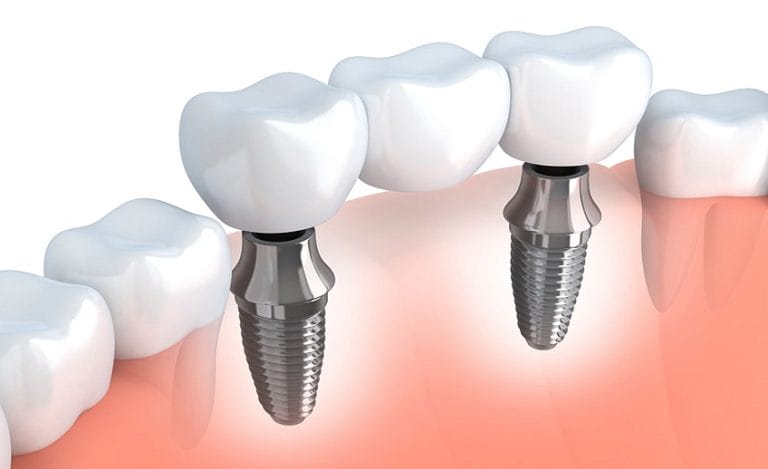Losing a tooth for any reason can bring both oral health and quality of life consequences. Luckily, today’s dental medicine has devised many options to help your mouth and jaw adjust and give you a cosmetic fix to remedy missing teeth. At 3V Dental Associates in Port Washington, we’re proud to be the leader in dental bridge technology in Port Washington, and the Long Island area.
A dental bridge is one such tool that your dentist may recommend after loss of one or more teeth. This dental device can work in a number of ways to accommodate tooth loss based on your personal situation.
In this article, learn what is a dental bridge for teeth, how does a bridge work to close gaps when a tooth is missing, different types of bridges, how to care for a bridge and more.
What Is a Dental Bridge?
This is a permanent prosthetic device that is designed to fill in gaps left by missing teeth.
According to the American Dental Association:
Sometimes called a fixed partial denture, a bridge replaces missing teeth with artificial teeth and literally “bridges” the gap where one or more teeth used to be. Bridges can be made from gold, alloys, porcelain or a combination of these materials and are attached to surrounding teeth for support. Unlike a removable bridge, which you can take out and clean, a fixed bridge can only be removed by a dentist.
The device has two main parts: the pontic and the abutment.
The pontic is a type of fake tooth that is positioned to fit into the place where the missing tooth (or teeth) used to be – literally “bridging” the gap and filling it in.
The abutment is a type of hook or wing structure that secures the device into place.
Why Are Dental Bridges Needed?
Bridges offer many benefits beyond simply restoring your smile.
They help to ensure structural integrity of your jaw, prevent tooth movement around the area of the gap, make it easier to chew and speak, guard against dental decay and gum disease and help safeguard the health of existing teeth.
They can also be faster and more economical to install than implants and they do not require any bone grafting prior to installation.
How Is a Dental Bridge Installed?
There are three different device types that can be used depending on how and where the tooth loss has occurred. Each device is permanent and cannot be removed (except by a dentist) once placed in the mouth.
Your dentist will be able to advise you on the best prosthetic type for your cosmetic and oral health needs.
What Are the Different Types of Dental Bridges?
The three different device types are as follows:
1. Standard Dental Bridge
This is the original device type, which is designed to be cemented to the two teeth on either side of the gap. It is also called a traditional or double-abutted device.
In the middle of the area of the gap there is a pontic to fill in the missing space.
2. Cantilever Dental Bridge
A cantilever device is quite rare and in most cases a dentist will recommend an implant over this type of device because implants are more secure.
However, if there is just one abutment tooth available around the gap (such as at the very back of the mouth or if multiple teeth are missing) a cantilever device can be used to fill in the gap.
3. Maryland Dental Bridge
A Maryland device is typically only recommended for areas of the mouth which do not bear the full brunt of bite and chew strength (such as at the front of the mouth).
This device has a pontic with “wings” on either side that are made of porcelain, resin or metal. These wings are what bond to the abutments on either side of the gap.
How Are These Dental Bridge Devices Placed in the Mouth?
Before one of these devices can be installed to fill in the gap left by a missing tooth, the teeth on either side of the gap must be prepared by your 3V Dental Associates dentist.
This is done by filing each one down and then placing a crown over each. This makes room for the pontic to fit into the gap and gives the abutment something stable and secure to attach to.
Taking the step to file down and crown any tooth that will help secure the device is important to safeguard the health of that tooth. Otherwise, the device may place unnecessary pressure on that tooth and cause stress that will eventually lead to cracks or even tooth loss.
Who Is a Good Candidate for a Dental Bridge?
A person who is a good candidate for this type of dental prosthetic device usually has overall good oral health and not more than three consecutive missing teeth in the area where the device will be placed.
Any serious dental health issues such as widespread decay or gum disease must be remedied before the prosthetic can be placed.
It is also important that each tooth the device will attach to is healthy and strong or can be made to be so by use of a crown or even a dental implant.
If you have significant bone loss in your jaw in the area where the device is to be placed, you may need to have bone grafting and an implant placed before the prosthetic can be secured. This can add time and expense to the process but will greatly increase the odds of a successful placement.
Why Not Just Get Dental Implants Instead of a Dental Bridge?
This is a great question and is one that only your dentist is qualified to answer. In some cases, you may need both to ensure the device has secure and stable support on each side of the pontic.
And in other cases, one or more implants may better serve your oral health needs or gap issues over the long term.
Your dentist will be able to examine your mouth and recommend the best approach.
Caring for Dental Prosthetics and Dental Bridges
Your dentist here at 3V Dental Associates in Port Washington will give you specific instructions to care for this permanent prosthetic device after it is placed.
Because the device is permanent, you won’t be able to remove it for cleaning or inspection. Luckily, lots of different basic tooth care aids exist to help you clean and care for your new prosthetic at home.
There are flossing and brushing aids plus mouth gargles to deal with plaque, tartar and germs such as bacteria. Daily care will ensure your mouth stays healthy once the device is in place.
To schedule your dental bridge appointment with 3V Dental Associates here at our lovely Port Washington dental clinic, contact our helpful staff today.



